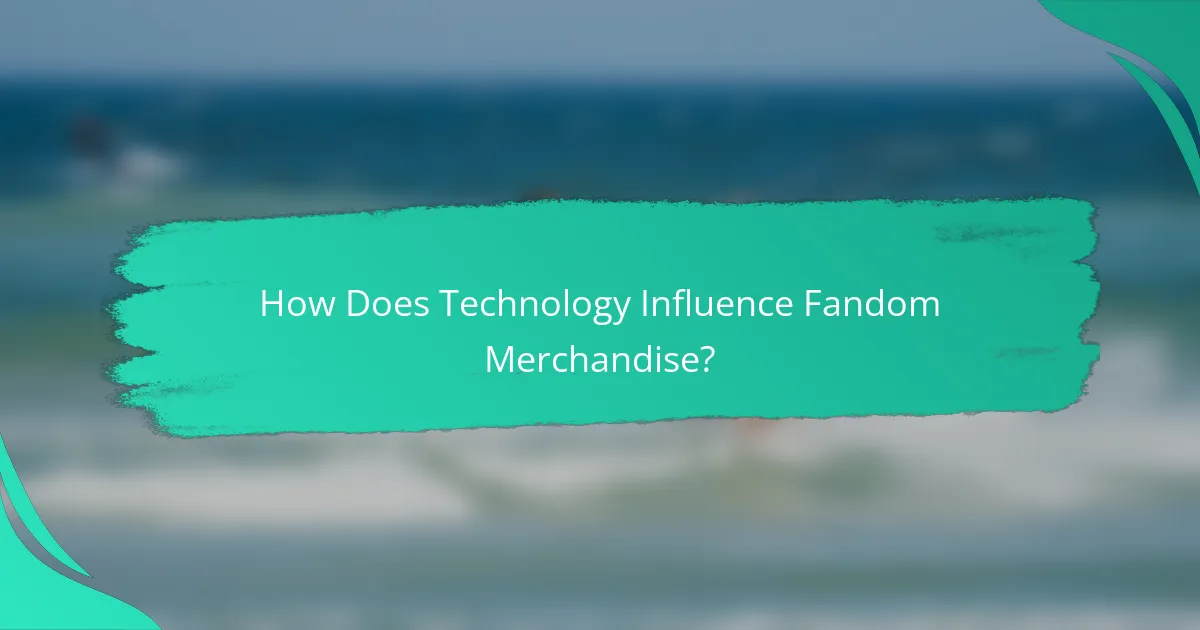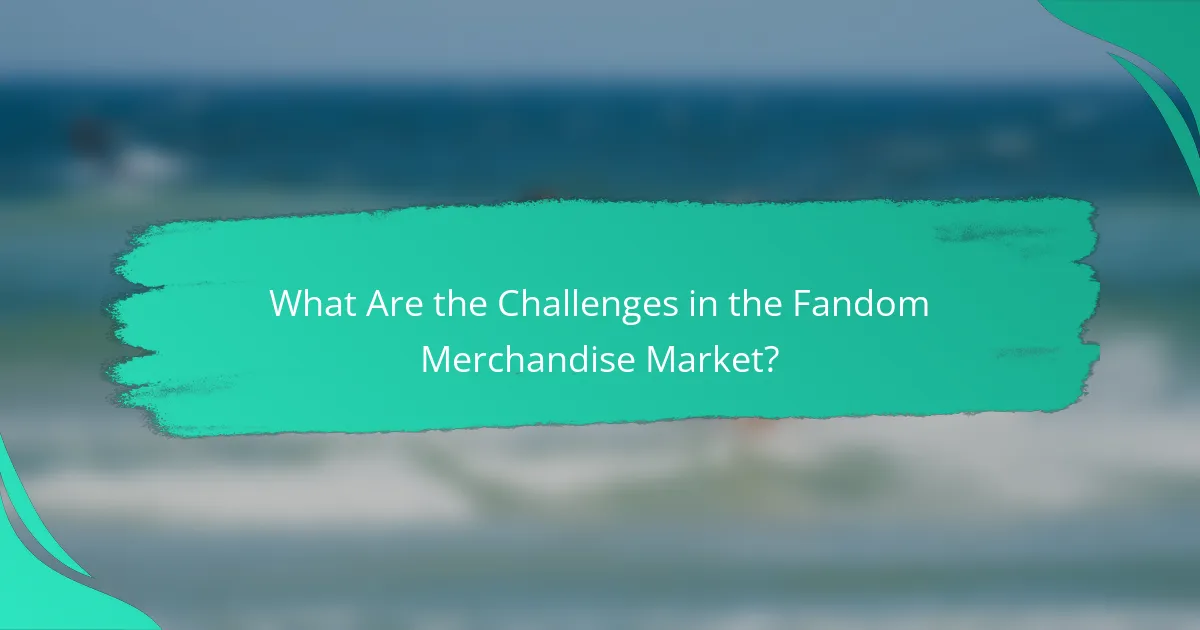The fandom merchandise market is rapidly evolving, driven by emerging trends such as digital collectibles, personalized products, and sustainability. As consumers increasingly seek items that reflect their individuality and values, businesses must adapt to these preferences to thrive. This dynamic landscape presents significant growth opportunities, particularly through online retail and innovative subscription services.

What Are the Key Trends in Fandom Merchandise?
Key trends in fandom merchandise include the rise of digital collectibles, personalized options, sustainable products, augmented reality integration, and collaborations with influencers. These trends reflect evolving consumer preferences and technological advancements, shaping how fans engage with their favorite franchises.
Rise of Digital Collectibles
Digital collectibles, such as NFTs (non-fungible tokens), are gaining popularity among fans, allowing them to own unique digital assets linked to their favorite franchises. These collectibles can include artwork, music, or exclusive content, often traded on blockchain platforms.
Fans appreciate the scarcity and authenticity that digital collectibles provide, making them a desirable addition to any collection. However, potential buyers should be aware of the fluctuating market values and the environmental concerns associated with blockchain technology.
Personalized Merchandise Options
Personalized merchandise allows fans to customize items like clothing, accessories, and collectibles with their names or favorite quotes. This trend enhances the emotional connection fans have with the products, making them feel more unique and special.
Brands are increasingly offering customization tools on their websites, enabling fans to create one-of-a-kind items. However, consumers should consider the potential for longer shipping times and higher costs associated with personalized products.
Sustainable Product Offerings
Sustainability is becoming a crucial factor in fandom merchandise, with brands focusing on eco-friendly materials and ethical production practices. Fans are increasingly seeking products that align with their values, pushing companies to adopt greener practices.
Examples include apparel made from organic cotton or recycled materials and packaging that minimizes waste. Brands should communicate their sustainability efforts clearly, as transparency can enhance consumer trust and loyalty.
Integration of Augmented Reality
Augmented reality (AR) is transforming how fans interact with merchandise, allowing them to visualize products in their environment before purchasing. AR applications can enhance the shopping experience by providing interactive features, such as virtual try-ons or 3D models of collectibles.
Brands that incorporate AR can engage consumers more effectively, leading to higher conversion rates. However, companies should ensure that the technology is user-friendly and accessible to avoid frustrating potential buyers.
Collaboration with Influencers
Collaborations with influencers are a powerful trend in fandom merchandise, as these partnerships can significantly boost brand visibility and credibility. Influencers often have dedicated fanbases that trust their recommendations, making them ideal for promoting products.
Brands should choose influencers whose values align with their own to create authentic partnerships. Additionally, they should consider the influencer’s engagement rates and audience demographics to maximize the impact of their campaigns.

How Are Consumer Preferences Shaping the Market?
Consumer preferences are significantly influencing the fandom merchandise market by driving demand for products that reflect individuality, sustainability, and exclusivity. As fans seek items that resonate with their personal identities and values, businesses must adapt to these evolving trends to remain competitive.
Demand for Unique Items
There is a growing demand for unique fandom merchandise that allows fans to express their individuality. Consumers are increasingly drawn to products that are not mass-produced, such as handmade crafts or custom designs, which can enhance their connection to the fandom.
Brands can capitalize on this trend by offering personalized items, such as custom apparel or bespoke collectibles. Engaging with local artists or creators can also provide unique offerings that stand out in a crowded market.
Preference for Eco-Friendly Products
Many consumers are prioritizing eco-friendly products in their purchasing decisions, reflecting a broader societal shift towards sustainability. Fandom merchandise that uses recycled materials or sustainable production methods is becoming more appealing to environmentally conscious fans.
To meet this demand, brands should consider sourcing materials responsibly and highlighting their eco-friendly practices in marketing. Offering products that are biodegradable or made from organic materials can also attract a dedicated customer base.
Interest in Limited Editions
Limited edition items are highly sought after in the fandom merchandise market, as they create a sense of urgency and exclusivity. Fans are often willing to pay a premium for products that are released in small quantities, making them feel special and part of an elite group.
Companies can leverage this interest by launching limited runs of popular items or collaborating with well-known franchises to create exclusive merchandise. Clear communication about the limited nature of these products can enhance their desirability.
Shift Towards Digital Experiences
There is a notable shift towards digital experiences in fandom merchandise, driven by advancements in technology and changing consumer habits. Fans are increasingly engaging with virtual products, such as digital collectibles or immersive online experiences, rather than traditional physical items.
Brands should explore opportunities in the digital space, such as offering virtual reality experiences or NFTs (non-fungible tokens) related to popular franchises. This approach not only caters to tech-savvy consumers but also opens new revenue streams in the evolving market landscape.

What Are the Growth Opportunities in the Fandom Merchandise Market?
The fandom merchandise market is experiencing significant growth opportunities driven by evolving consumer preferences and technological advancements. Key areas for expansion include online retail platforms, subscription services, and global market penetration.
Expansion of Online Retail Platforms
Online retail platforms have become essential for fandom merchandise, allowing fans to access a wide range of products from anywhere. Major e-commerce sites and niche platforms cater specifically to fandoms, offering exclusive items and limited editions that attract collectors.
Brands should consider optimizing their online presence by utilizing social media marketing and influencer partnerships to reach targeted audiences. Ensuring a seamless shopping experience, including mobile compatibility and easy checkout processes, can significantly enhance customer satisfaction and retention.
Emergence of Subscription Services
Subscription services are gaining traction in the fandom merchandise sector, providing fans with curated products delivered regularly. These services often include exclusive items that are not available through traditional retail channels, creating a sense of excitement and anticipation among subscribers.
Businesses can benefit from this model by offering tiered subscription plans that cater to different budgets and preferences. It’s crucial to maintain high-quality offerings and engage subscribers with regular updates and community-building activities to reduce churn rates.
Global Market Penetration
As fandom culture becomes increasingly global, brands have opportunities to penetrate international markets. Understanding local preferences and cultural nuances is vital for successful market entry, as fandom interests can vary significantly across regions.
Companies should conduct market research to identify potential demand and tailor their offerings accordingly. Collaborating with local influencers and participating in regional events can enhance brand visibility and foster a loyal customer base in new markets.

What Criteria Should Businesses Consider for Fandom Merchandise?
Businesses should focus on understanding their target audience, ensuring high product quality, and exploring effective brand collaborations to succeed in the fandom merchandise market. These criteria help in creating products that resonate with fans and drive sales.
Target Audience Analysis
Identifying the target audience is crucial for fandom merchandise. Businesses should analyze demographics, interests, and purchasing behaviors of fans to tailor products that meet their preferences. Engaging with fan communities through social media or surveys can provide valuable insights.
Consider segmenting the audience based on factors like age, fandom size, and spending habits. For example, younger fans may prefer trendy items, while older fans might appreciate collectibles. This segmentation allows for more targeted marketing strategies.
Product Quality Standards
Maintaining high product quality is essential in the fandom merchandise sector. Consumers expect durable and well-made items that reflect their favorite franchises. Businesses should establish quality control processes to ensure that products meet or exceed industry standards.
Using quality materials and reputable manufacturers can enhance the perceived value of merchandise. For instance, apparel made from sustainable fabrics may appeal to environmentally conscious fans, while limited-edition collectibles should feature premium craftsmanship to attract collectors.
Brand Collaboration Strategies
Collaborating with established brands or franchises can significantly boost the visibility and credibility of fandom merchandise. Businesses should seek partnerships that align with their target audience’s interests and values, creating co-branded products that leverage both brands’ strengths.
Effective collaboration can take various forms, such as exclusive merchandise launches or joint marketing campaigns. For example, a popular gaming franchise might partner with a clothing brand to create themed apparel, tapping into both fan bases and expanding reach.

How Does Technology Influence Fandom Merchandise?
Technology significantly shapes fandom merchandise by enhancing accessibility, personalization, and engagement. Innovations in e-commerce, social media, and data analytics create new opportunities for fans to connect with their favorite franchises and acquire related products.
Impact of E-commerce Platforms
E-commerce platforms have revolutionized how fandom merchandise is sold and distributed. Major retailers like Amazon and niche sites dedicated to specific fandoms allow fans to easily find and purchase items from anywhere in the world.
These platforms often feature user-friendly interfaces, enabling fans to browse extensive catalogs and compare prices. Additionally, many offer subscription services or exclusive deals, which can drive consumer loyalty and increase sales.
Role of Social Media Marketing
Social media marketing plays a crucial role in promoting fandom merchandise by leveraging platforms like Instagram, Twitter, and TikTok. Brands can engage directly with fans, showcasing new products and generating buzz through targeted advertising and influencer partnerships.
Effective campaigns often include interactive content, such as polls or giveaways, which encourage fan participation and create a sense of community. This approach not only boosts visibility but also fosters a deeper emotional connection to the merchandise.
Use of Data Analytics for Trends
Data analytics is essential for understanding consumer preferences and market trends in fandom merchandise. By analyzing purchasing patterns, brands can identify which products resonate most with fans and adjust their offerings accordingly.
Tools like Google Trends and social media insights provide valuable information on emerging interests, allowing companies to stay ahead of the curve. Utilizing this data can lead to more effective marketing strategies and product development, ensuring that merchandise aligns with fan expectations.

What Are the Challenges in the Fandom Merchandise Market?
The fandom merchandise market faces several challenges, including intense competition, fluctuating consumer preferences, and issues related to licensing and copyright. These factors can impact profitability and market growth, making it essential for businesses to adapt quickly.
Competition from Counterfeit Products
Counterfeit products pose a significant challenge in the fandom merchandise market. These imitation items often undercut legitimate brands on price, attracting budget-conscious consumers. Businesses must invest in brand protection and educate fans about the value of authentic merchandise.
Shifting Consumer Preferences
Consumer preferences in fandom merchandise can change rapidly, influenced by trends in media and pop culture. Companies need to stay attuned to these shifts, regularly updating their product lines to reflect current interests. Engaging with fan communities through social media can provide valuable insights into emerging trends.
Licensing and Copyright Issues
Licensing and copyright issues are critical in the fandom merchandise market, as unauthorized use of intellectual property can lead to legal disputes. Brands must navigate complex agreements with rights holders to ensure compliance. It’s advisable to consult legal experts when entering licensing agreements to avoid potential pitfalls.
Supply Chain Disruptions
Supply chain disruptions can significantly impact the availability of fandom merchandise. Factors such as global shipping delays, material shortages, and production issues can lead to stockouts. Businesses should consider diversifying their suppliers and maintaining a buffer stock to mitigate these risks.
Market Saturation
Market saturation is another challenge, as the proliferation of products can make it difficult for new entrants to gain traction. Companies must differentiate their offerings through unique designs or exclusive collaborations. Focusing on niche markets or limited-edition items can also help capture consumer interest.
